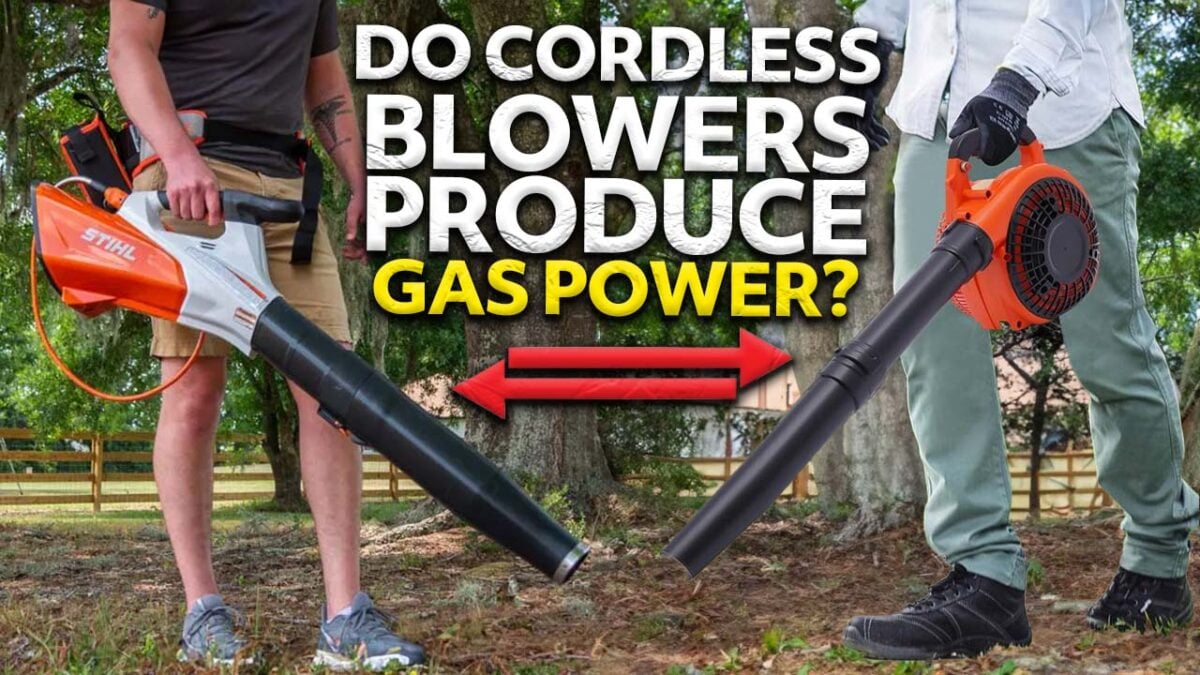If you’ve spent much time shopping for leaf blowers, there’s a good chance you’ve seen many battery-powered ones claim “gas-like power,” “gas performance,” or something similar. But are cordless leaf blowers really as powerful as gas models?
The short answer is, sometimes.
We’ve been testing battery-powered blowers since 2013 and have our own force meter to measure whether manufacturers’ claims stand up to real-world use. I’ll share what we’ve learned and help you decide whether it’s worth switching over to a battery-powered solution.
Handheld Leaf Blowers
Let’s start with some context. First, we look to Newtons as a way to measure blowing force. Rather than considering airspeed (MPH) or airflow (CFM), Newton force is a better measure of a blower’s actual work. As a bonus, it evens out any discrepancies in how MPH and CFM are measured since ANSI has a test method for it.
Pro Tip: A Newton is the amount of force needed to accelerate 1 kg of mass at the rate of 1 m/sec²
To keep the weight manageable, handheld gas blowers usually have engines in the 25cc – 27cc range. At that level, residential models can produce up to 13 Newtons of blowing force. Professional ones can reach as high as 15 Newtons.
Today, many brands have cordless blowers that exceed the 15-Newton mark, including residential and Pro brands. Several even reach beyond 20 Newtons.
There’s a key difference between gas engines and electric motors, though. Today’s brushless motors and electronic controls allow product teams to include a Turbo button that gives a momentary burst of power and reach higher blowing force values. Gas engines don’t have that capability.
The key word there is “momentary.” The turbo mode zaps your battery quickly, so it’s not designed to be the full-time operating mode. Instead, it’s intent is to help you move stubborn debris before dialing back to the standard operating power levels.
So, when you’re comparing the blowing force of cordless and gas leaf blowers, the measurement in high is a better comparison to a gas model’s wide-open throttle (WOT). Even if you take the turbo force out of the equation, there are many battery-powered options that really do meet or exceed the power of their gas counterparts.
Backpack Leaf Blowers
But what about backpack blowers?
That’s a different story. With engines reaching 79cc, the strongest backpack blower we’ve tested (Echo’s PB-9010T) measured a whopping 52 Newtons! Residential models are a bit more tame, topping out around 30 Newtons.
Until recently, battery-powered backpack blowers weren’t even playing in the same league. However, there are models now that produce Newton force in the mid-20s. Greenworks Commercial and Echo both have options that produce up to 36 Newtons.
While that definitely closes the gap on gas, the disclaimer is the same—cordless backpack blowers have a turbo button, and they’re only meant to be used for short bursts at their highest levels. Their steady-state blowing forces are lower.
Final Thoughts
If you maintain your own lawn, replacing a gas or corded electric handheld blower with a battery-powered one makes a lot of sense. There’s enough blowing force to meet or exceed what gas can deliver, and today’s batteries can produce the runtime you need for post-mowing and fall leaf cleanup. The biggest hesitation might be the price, depending on what performance level and brand you’re considering.
For Pros, it’s not quite as straightforward. Pro-grade handheld blowers are easily replaced by cordless models. Backpack blowers are getting there, and there are some options to fully replace entry-level Pro models. However, lawn care crews and landscapers also have to weigh the higher cost of entry and determine how to manage the number of batteries it takes to get through the day. Even though the fuel and maintenance cost savings add up, many crews are still hesitant to make the switch.



